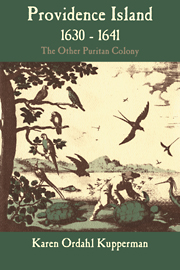Book contents
- Frontmatter
- Contents
- List of Maps
- Preface
- Author's Note
- 1 The Providence Island Company and Its Colony: The Program
- 2 Founding a Colony on Providence Island
- 3 Contested Authority: The Governorship of Captain Philip Bell
- 4 Frustrated Hopes for Economic Development
- 5 Land and Society: The Middling Planters
- 6 Servants into Slaves
- 7 Military Requirements and the People's Response
- 8 The Turbulent Religious Life of Providence Island
- 9 Governing Puritan Privateers: The Governorships of Robert Hunt and Nathaniel Butler
- 10 The Business History of the Providence Island Company
- 11 The End and Persistence of Providence Island
- Appendixes
- Bibliographical Essay
- Index
6 - Servants into Slaves
Published online by Cambridge University Press: 24 November 2009
- Frontmatter
- Contents
- List of Maps
- Preface
- Author's Note
- 1 The Providence Island Company and Its Colony: The Program
- 2 Founding a Colony on Providence Island
- 3 Contested Authority: The Governorship of Captain Philip Bell
- 4 Frustrated Hopes for Economic Development
- 5 Land and Society: The Middling Planters
- 6 Servants into Slaves
- 7 Military Requirements and the People's Response
- 8 The Turbulent Religious Life of Providence Island
- 9 Governing Puritan Privateers: The Governorships of Robert Hunt and Nathaniel Butler
- 10 The Business History of the Providence Island Company
- 11 The End and Persistence of Providence Island
- Appendixes
- Bibliographical Essay
- Index
Summary
ON JULY 19, 1634, the Earl of Warwick wrote to Hugh Wentworth, his agent in Bermuda, about management of his plantations there. One concern was the use planters made of slaves belonging to the earl. He wanted “my negroes” best placed “with regard to my profit” and requested details of their distribution and the terms on which tenants acquired their labor. Like his land, they were property, their role to enrich the earl and to develop his estate. The logic of this position stumbled on the fact that the slaves were also human beings who could make a claim on his Christian sensibilities. In the same letter he wrote of a complaint received from “Sander, one of my negroes,” against a planter named Winter for selling Sander's child. Sander also asked that his wife be allowed to live with him. Warwick, cautious because he admitted he did not know all the “particular grounds,” asked Wentworth to investigate and to help “the poor man in all lawful office of favour.” He especially hoped man and wife could be together, “it seeming to me a request full of reason.” His letter concluded by conceding Wentworth's superior knowledge of the facts and acquiescing in whatever decision he made. Warwick stipulated that Sander should be informed of his interest in the case. Thus, Wentworth was placed in the classic overseer's bind: he was commanded to maximize profits while communicating the owner's fatherly concern for the slave's welfare.
This letter encapsulates a problem slowly worked out over the succeeding two centuries in American history. The independence offered planters by their acquisition of land in America ultimately meant loss of freedom and individuality for other men and women who were themselves defined as property and who thus contributed to freeholders' status.
- Type
- Chapter
- Information
- Providence Island, 1630–1641The Other Puritan Colony, pp. 149 - 180Publisher: Cambridge University PressPrint publication year: 1993

